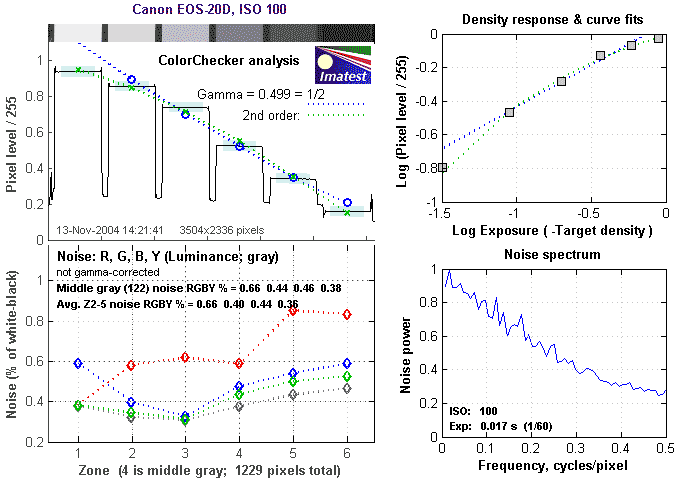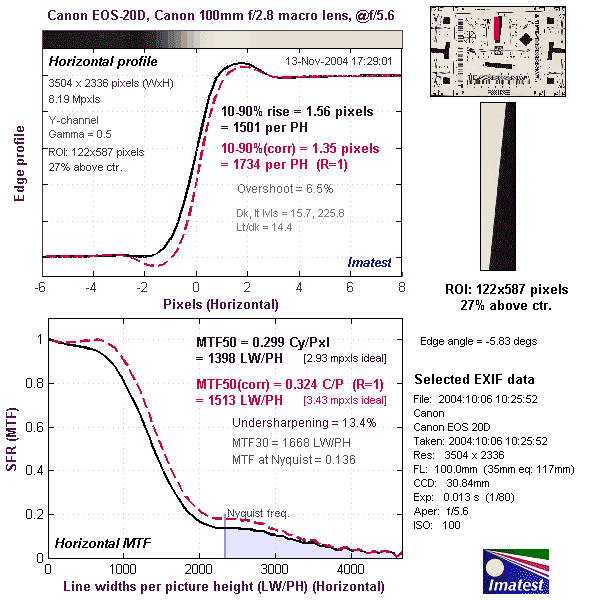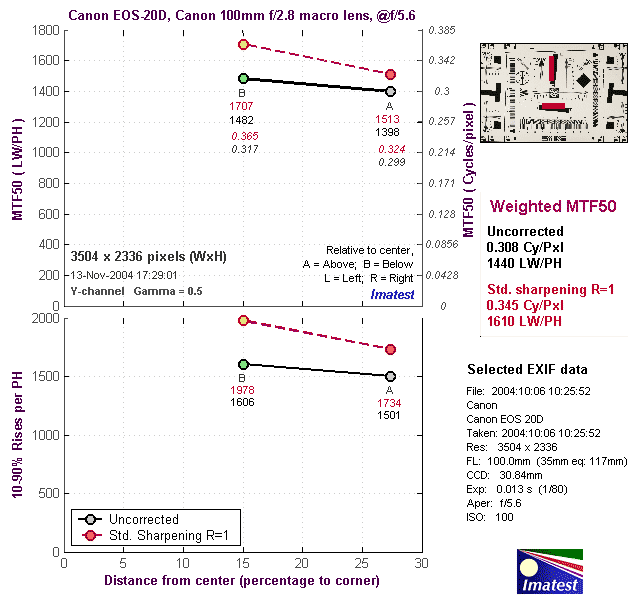Canon EOS 20DBy: Shawn Barnett and Dave EtchellsSlightly smaller and lighter upgrade brings greater speed and ease of use along with higher res and lower image noise. <<EOS 20D Sample Images :(Previous) | (Next): Print-Friendly Review Version>> EOS 20D Imatest ResultsReview First Posted: 08/19/2004, Update: 11/19/2004 |
Detailed analysis of the Canon EOS 20D images, from Imatest(tm)
I've recently begun using Norman Koren's excellent "Imatest" analysis program for quantitative, thoroughly objective analysis of digicam test images. I highly commend it to our technically-oriented readers, as it's far and away the best, most comprehensive analysis program I've found to date. (And with an introductory price of only $59, it's hard to beat.)
My comments below are just brief observations of what I see in the Imatest results. A full discussion of all the data Imatest produces is really beyond the scope of this review: Visit the Imatest web site for a full discussion of what the program measures, how it performs its computations, and how to interpret its output.
Here's some of the results produced by Imatest for the Canon EOS 20D:
Color Accuracy
Overall, the Canon EOS-20D has very good to excellent hue accuracy in its
default color mode. Like most digital cameras, it tends to oversaturate reds
slightly, albeit not as much as some competing models do. In other parts of
the spectrum it's quite restrained, with relatively small amounts of over-
and under-saturation. (Slight oversaturation of blues and some greens, slight
undersaturation of yellow-greens and yellows, bright yellows showing the most
undersaturation.) On average, color saturation of swatches on the MacBeth
ColorChecker(tm) chart are 106.9% of their ideal values. (An average oversaturation
of 6.9%.)
Color Analysis
These images show the color behavior of the 20D directly. In each color swatch,
the outer perimeter shows the color as actually captured by the camera, the
inner square shows the color after correcting for the luminance of the photographed
chart (as determined by a 2nd-order curve fit to the values of the gray swatches),
and the small rectangle inside the inner square shows what the color should
actually be, based on perfect rendering to the sRGB color spacer. As I've seen
in many cameras, the 20D seems to brighten some colors a fair bit, even after
correcting for gamma deviations in the gray scale. Thus, while the chromaticity
of highly-saturated colors are either close to accurate or slightly depressed,
a luminance boost in those colors gives them a bright, appealing look that masks
any undersaturation. (This is particularly evident in the yellows and yellow-greens
in the MacBeth chart, an area of the spectrum in which the 20D technically undersaturates
the color somewhat.)
Gray Patch Tone and Noise Analysis

There's a lot in this particular graph, a lot more than I have room to go into
here. Bottom line, the 20D's noise levels are very low, with significant
high-frequency content, which gives the noise a very fine-grained characteristic
that minimizes its visual impact.
This chart compares the 20D's noise performance over a range of ISOs against that of competing digital SLRs. As you can see, all of the models shown here fall more or less in line at ISOs from 100-800. Where the 20D really starts to shine is at ISO1600, where noise levels are virtually identical to those at ISO 800, putting it a full f-stop ahead of the other models shown here. (Note too, the difference at high ISO between the 20D and the 1D Mark II: The 20D incorporates additional noise-suppression technology that was developed after the 1D Mark II sensor entered production. The impact is clear, with markedly better performance by the 20D at ISO 1600 and 3200.)
What this chart doesn't show is how well each camera holds onto subject detail in areas of subtle contrast. Most anti-noise algorithms flatten out subject detail in areas with low local contrast (good examples are hair and grass or pine needles in shots with foliage in them). The Canon 20D though, does an unusually good job of preserving detail in such areas. Also not evident here is how fine-grained the 20D's noise pattern is at high ISOs. This makes the noise that is present much less objectionable, making even its ISO 3200 shots highly usable for many applications.
All in all, the 20D's very "clean" looking images and tight noise
structure is to my mind an important part of the overall story of the camera.
- The 20D really opens up high-ISO photography at a very affordable price point.
the 20D is somewhat noisier than average across the board, particularly so at
ISO 400, although its noise levels are lower than those of the lower-resolution
A85 at all ISOs. - The positive side of this though, is that the camera tends
to hold onto detail in subject areas of subtle contrast better than many competing
models do. (The Sony DSC-P100 being a case in point: It has very low noise figures
numerically speaking, but it trades away a tremendous amount of subject detail
to achieve the low noise specs. - Happily though, that behavior isn't at all
shared by the higher-resolution Sony DSC-P150...)
The chart above shows consolidated results from spatial frequency response
measurements in both the horizontal and vertical axes. The "MTF 50"
numbers tend to correlate best with visual perceptions of sharpness, so those
are what I focus on here. The uncorrected resolution figures are 1398 line widths
per picture height in the horizontal direction (corresponding to the vertically-oriented
edge), and 1482 along the vertical axis (corresponding to the horizontally-oriented
edge), for a combined average of 1440 LW/PH. Correcting to a "standardized"
sharpening with a one-pixel radius increases this number slightly, to an average
of 1610 LW/PH.
For the real techno-geeks, the two plots below show the actual edge response
of the 20D, for horizontal and vertical edge. What's interesting in these plots
is how subtle the 20D's internal sharpening is, and how little it disturbs the
underlying image detail.




Follow Imaging Resource: